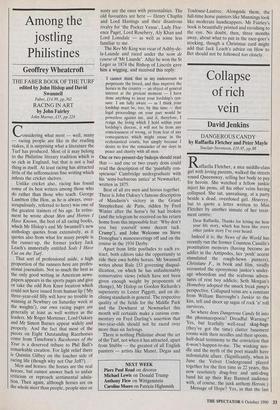Among the jostling Philistines
Geoffrey Wheatcroft
THE FABER BOOK OF THE TURF edited by John Hislop and David Swannell
Faber, £14.99, pp-362
RACING IN ART by John Fairley
John Murray, £35, pp.224
Considering what most — well, many — racing people are like in the reading stakes, it is surprising what a literature the Turf has produced. Most of it may belong to the Philistine literary tradition which is so rich in England, but that is not a bad thing in itself. At least racing has attracted little of the selfconscious fine writing which infests the cricket shelves.
Unlike cricket also, racing has found some of its best writers among those who do rather than those who teach. George Lambton (the Hon, as he is always, over- scrupulously, referred to here) was one of the greatest trainers of his age. In retire- ment he wrote about Men and Horses I Have Known, the best of all racing books, which Mr Hislop's and Mr Swannell's new anthology quotes from extensively, as it quotes also from what for many people is the runner-up, the former jockey Jack Leach's immortally entitled Sods I Have Cut on the Turf. . That sort of professional aside, a high proportion of the runners here are profes- sional journalists. Not so much the best as the only good writing in American news- papers appears in the sports pages and give or take the odd Ron Knee locution which could not have issued from human lip (`My three-year-old filly will have no trouble in winning at Newbury on Saturday week at the weights'), our own racing pages are generally at least as well written as the leaders. Mr Roger Mortimer, Lord Oaksey and Mr Simon Barnes appear widely and properly. And the fact that most of the pieces on Eight Outstanding Racehorses come from Timeform's Racehorses of the Year is a deserved tribute to Phil Bull's remarkable creation. For light relief there is Quintin Gilbey on the loucher side of racing life (though why not Our Jeff?). Men and horses: the horses are the real heroes, but cannot answer back to unfair criticism or reproach sentimental adula- tion. Then again, although horses are on the whole nicer than people, people nice or
nasty are the ones with personalities. The old favourites are here — Henry Chaplin and Lord Hastings and their disastrous rivalry for 'the Pocket Venus', Lady Flor- ence Paget, Lord Rosebery, Aly Khan and Lord Lonsdale — as well as some less familiar to me.
The Rev Mr King was vicar of Ashby-de- la-Launde and raced under the nom de course of 'Mr Launde'. After he won the St Leger in 1874 the Bishop of Lincoln gave him a wigging, and received this reply:
I cannot think that in my endeavours to perpetuate the breed, and thus improve the horses in the country — an object of general interest at the present moment — I have done anything to incur your lordship's cen- sure. I am fully aware — as I think your lordship must be, too, by this time — that legal proceedings on your part would be powerless against me, and if, therefore, I resign the living which I hold within your lordship's diocese, it will not be from any consciousness of wrong, or from fear of any consequences which might ensue in the ecclesiastical courts, but simply because I desire to live the remainder of my days in peace and charity with all men.
One or two present-day bishops should read that — and one or two crusty dons could read the description of the 'painfully con- spicuous' Cambridge undergraduate with his 'semi-barbarous antics' at Newmarket, written in 1875.
Best of all are men and horses together. There is John Oaksey's famous description of Mandarin's victory in the Grand Steeplechase de Paris, ridden by Fred Winter after the horse's bit had broken (and the telegram he received on his return home from this impossible feat: 'Why don't you buy yourself some decent tack. Crump'), and John Welcome on Steve Donoghue's manoeuverings off and on the course in the 1934 Derby.
Apart from little postludes to each ex- tract, both editors take the opportunity to ride their own hobby horses. Mr Swannell writes about Rule 153 governing disqual- ification, on which he has unfashionably conservative views (which have not been given enough weight by proponents of change), Mr Hislop on Gordon Richards's superiority to Lester Piggott, and on de- clining standards in general. The respective quality of the fields for the Middle Park and the Dewhurst at Newmarket this month will certainly make a curious com- mentary on Fred Darling's assertion that two-year-olds should not be raced over more than six furlongs.
There is nothing Philistine about the art of the Turf, not when it has attracted, apart from Stubbs — the greatest of all English painters — artists like Manet, Degas and Toulouse-Lautrec. Alongside them, the full-time horse painters like Munnings look like moderate handicappers. Mr Fairley's book is beautifully printed and ravishing to the eye. No doubt, then, three months away, about what to put in the race-goer's stocking, though a Christmas card might add that Jack Leach's advice on How to Bet should not be followed too closely.


















































 Previous page
Previous page